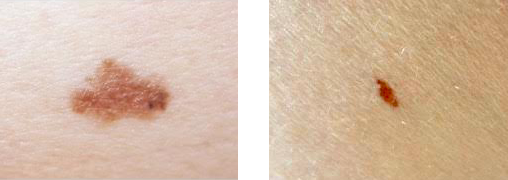March 16, 2017 | Stephen Fine, Founder and President
In-Situ Melanoma
In-Situ (In place) Melanoma is also known as Stage 0 Melanoma and Hutchinson’s melanotic freckle. The latter is in honor of Sir John Hutchinson, who provided its inaugural description in the late 19th century.
While our fervent goal is to continually help prevent people from developing melanoma, if you are diagnosed with it, this is the type you’d prefer. As with burns (1st, 2nd, 3rd degree) and golf scores, with melanoma the lower number you have the better.
What are In-Situ Melanomas?
In-Situ are radial melanomas that stay within the skin’s thin top layer. Unlike their far more dangerous cousins, they don’t penetrate the epidermis and spread throughout the body. They don’t move. Hence, in place.
They’re also very easy to see, and have nearly a 100% cure rate. Typically, a doctor simply removes them right in his or her office. And that’s that.
These are two examples of In-Situ Melanomas:

Lentigo Maligna and Lentigo Maligna Melanoma
Lentigo Maligna is a very slow-growing (up to 20 years) In-Situ melanoma. It develops most often in older people, and within those whose vocations require a significant amount of time spent outdoors. As its primary cause is sun exposure, “Lentigos” usually occur on the areas of skin that are most prone to be impacted by the sun’s harmful UV rays. These include- but are certainly not limited to -the hands, neck and face.
Of all the In-Situ varieties, Lentigo Maligna is the least likely to convert to an aggressive, potentially lethal skin cancer. If it does however, it becomes Lentigo Maligna Melanoma. If Lentigos are allowed to reach this invasive melanoma stage, the matter grows much more serious.
Unlike the aforementioned Lentigo Maligna, Lentigo Maligna Melanoma is not a simple out-patient procedure. It requires surgery during which the surgeon will remove the affected skin entirely; along with a portion of the healthy skin that surrounds it. How it’s treated is based on what the case’s pathologist determines.
From left to right the pictures are examples of Lentigo, Lentigo Maligna and Lentigo Maligna Melanoma:

While we may sound like a broken record at times, these, along with so many other skin cancer and sun skin damage issues, can be avoided merely by practicing sun-safety and monthly self-examination. Please, do it for your own sake; and for the sake of those who care about you.
Thank you.
Additional sources: Aimatmelanoma.org, emedicine.medscape.com, Dermnetnz.org (New Zealand)
